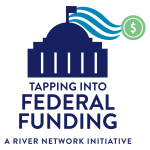Unpacking the Barriers to Accessing Federal Dollars
In the wake of new legislation, communities and groups working on climate infrastructure are scrambling to take advantage of massive, newly available funding opportunities. The passage of the Bipartisan Infrastructure Law and the Inflation Reduction Act made more money than ever before available to fund climate resilient infrastructure. Billions of dollars in federal grants are available through the Federal Emergency Management Agency (FEMA), the National Oceanic and Atmospheric Administration (NOAA), the Environmental Protection Agency (EPA), and other agencies to put money back into communities to help them prepare against flood, drought, storms, and other climate- related disasters. Additionally, in 2021, President Joe Biden started the Justice40 initiative which requires 40% of funds from qualifying government programs to be invested in disadvantaged communities. The combination of these three pieces of legislation has created a once-in-a-lifetime opportunity to change the way the United States tackles the climate crisis.
However, applying to a federal funding program is no small feat—especially for groups that don’t have experience with federal funding. Typically, applicants may include states, municipalities, 501c3 organizations, tribes, and for-profit organizations. Across these applicants there is a massive range in monetary resources, institutional knowledge, staff capacity, and degree to which applicants are impacted by systemic inequities. For communities and organizations without ample staff-capacity, large budgets, or institutional knowledge and power, navigating the massive amounts of new funding can be overwhelming and, at times, out of reach due to stringent requirements.
For perspective, federal grant applications often take at minimum 120 hours of staff time, as opposed to 30-50 hours for private or local grant programs. The depth and complexity of these applications makes it difficult for organizations and municipalities with fewer resources to assemble strong proposals. In many cases, that means communities shy away from applying, and often receive outright rejection when they do. Even as many agencies work to engage disadvantaged communities, there is still a capacity gap. Gloria McNair, Community Engagement Coordinator for Groundwork Jacksonville shared her perspective, “More agencies are interested in the human factor than ever before, but it’s a massive lift to put those stories together” she explained, “The more work you’re willing to put in the more likely you are to be awarded the funding, but that’s difficult for limited capacity groups.” Groundwork Jacksonville received funding from NOAA to advance nature-based climate resilience and community engagement projects in Jacksonville. Applying for those funds wasn’t easy and required institutional know-how and many dedicated staff hours. In some cases, even accessing the application is a challenge – for many funding programs, applicants must navigate complex registrations with various government programs (e.g. FEMAGO.gov, SAM.gov) – and once they do, the application sites are densely -written, not-user-friendly and can take hours of time and effort to navigate.
Beyond technical challenges, many federal funding programs have requirements that make prospective applicants with fewer resources and limited capacity ineligible. These requirements are meant to ensure accountability for grantees, but they can also limit the reach of these grants. For example, most grant programs under NOAA that are open to organizations require a 501c3 certification from the IRS, which disqualifies many community-based groups that do significant and comprehensive work. Attaining a 501c3 status is a difficult and time-consuming process itself that may not make sense for all groups to pursue for many reasons, capacity-related and otherwise. But even this is just the tip of the iceberg when it comes to accessibility issues in federal grant program requirements. Thankfully, there have been many efforts both inside and outside the federal government to reform grant requirements and make them more accessible.
In 2022, FEMA reformed its highly critiqued Benefit-Cost Analysis system that it uses to determine whether or not specific recovery and resilience projects are valuable enough to invest in. As a loose summary, the reform essentially lowered the required ratio of benefit to cost for communities that qualify as disadvantaged. Before this, wealthier communities had an advantage when applying for FEMA grants because they often already have infrastructure that makes mitigation and resilience projects cheaper to execute and more cost-effective. It also hurts low-income rural communities that often require larger hazard mitigation projects to protect fewer people. FEMA has also long been under fire for their disproportionate aid to white communities over Black, Indigenous, and communities of color, which is exacerbated by the Benefit-Cost Analysis system since white communities hold a disproportionately large amount of the wealth in this country. The reform is an attempt to rectify inequity in FEMA’s grant programs, but it’s yet to be seen if it is comprehensive enough to address the myriad criticisms of their Benefit-Cost Analysis system.
Perhaps the steepest barriers to accessing federal funding are local matching requirements. Local matching requirements are the portion of funds that applicants are required to raise on their own in order to receive money from federal programs. According to a report from Headwaters Economics, “More than 60% of federal resilience funding in the Bipartisan Infrastructure Law requires a local match, with an additional 13% requiring a match under certain conditions.” Like 501c3 requirements and Benefit-Cost requirements, the local matching requirements are a tool for the federal government to push for accountability from their grantees. However, it creates disproportionate and often insurmountable barriers for low-income communities that don’t have the same access to funding sources that wealthier communities have. The local cost share can discourage low-income communities from applying altogether.
Some agencies have tackled this inequity head on. In 2022, the US Forest Service made a great stride toward rectifying this when they waived all non-statute required match requirements for tribes and underserved communities. In the announcement, US Forest Service Chief Randy Moore explained, “I am taking steps to make it easier to partner with tribal governments and partners who work with underserved communities, in recognition of our trust and treaty obligations to Tribes, our commitment to serving all Americans, and the importance of gaining benefit and knowledge through relationships with communities that have been historically underrepresented in our partnerships.”
Now, more than ever, communities and organizations need support and resources for navigating federal funding opportunities and overcoming these barriers. We also need directed advocacy efforts to push for accountability from the federal government to ensure low-income and limited-capacity communities aren’t left behind as the United States acts on climate resilience. Many organizations, coalitions, and individuals are already stepping up to the challenge, calling out the shortcomings of federal funding programs, petitioning agencies to do better, and rallying efforts to make under-served voices heard. Many agencies are also looking for feedback on their programs through Requests for Information and Comment Periods. If you’d like to get updates on when these feedback opportunities open, we share many of these opportunities in our Online Community.
River Network is working to build out our resources on climate resilience and tapping into federal dollars via a new collection of resources on our Tapping Into Federal Funding hub, where new resources and events are regularly being added. Keep an eye out for new learning opportunities and advocacy efforts as we deepen our work and knowledge in these areas! We are here to support YOU in bringing these dollars to your communities – reach out to me or any other member of our staff to share your organization’s challenges, needs, and other areas of support.







[…] solutions depends on local communities – communities where planners are often stretched thin and lack the time and resources to navigate the complex world of federal funding […]
[…] and attempt to address the typical barriers to accessing federal funding through the design of our application process and providing robust technical assistance to minimize […]